Indian football grappling with a midfield conundrum
During the Indian Super League (ISL) knockout match between Odisha FC and Kerala Blasters in April this year, Ahmed Jahouh executed a pass few would dare to attempt at 1-1 in extra time.
The deep-lying midfielder of Odisha arrowed in a straight first-time no-look pass over the Blasters’ defence and found Roy Krishna, whose well-timed run behind a flat-footed opposition backline allowed him to set up Isak Ralte for the match-winner.
Even at 35, Jahouh’s mastery over the ball continues to leave many spellbound. He can dictate the pace of play — deciding when to speed up proceedings or slow it down to provide control in possession — and when to switch play with his range of passing capabilities. A midfielder like him can have a transformative effect on a football team, as Odisha discovered by bringing the pass master from Mumbai City FC.
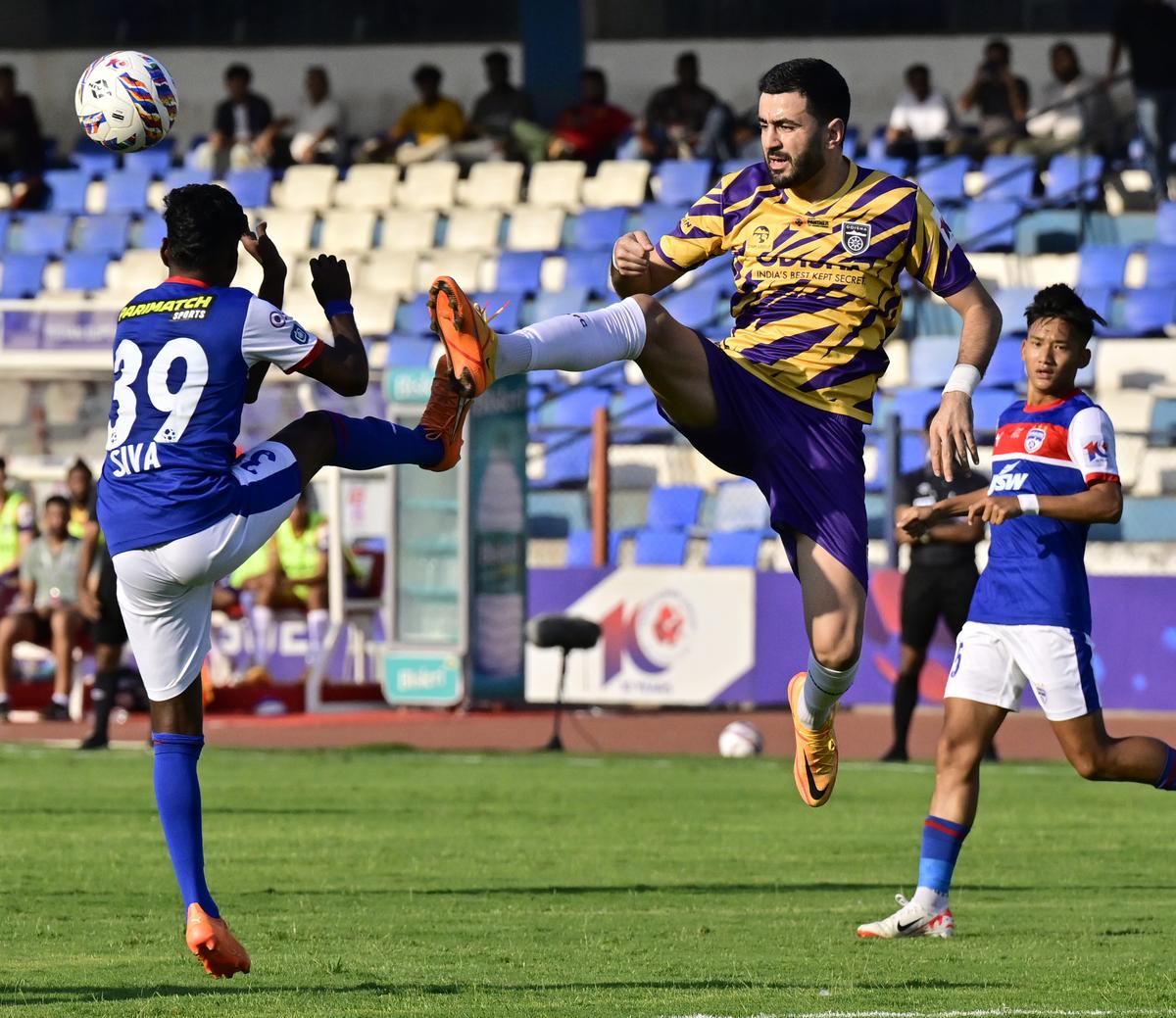
Old is gold: Even at 35, Janouh’s (yellow) mastery continues to leave many spellbound.
| Photo Credit:
K. Murali Kumar
Old is gold: Even at 35, Janouh’s (yellow) mastery continues to leave many spellbound.
| Photo Credit:
K. Murali Kumar
In his seven ISL seasons, the Moroccan has made a significant impact across three teams: FC Goa and Mumbai City FC (both of which won the ISL Shield and multiple ISL championships with him pulling strings in the midfield), and Odisha FC, the latest beneficiary of his arrival on the east coast.
Since 2017, he has had the highest number of passes among midfielders in five seasons. This year was no different, as he registered 1367 successful passes, 369 more than the next best, while playing two games fewer.
Even though Odisha did not win the ISL Shield or the ISL title with Jahouh in its fold, the Juggernauts were legitimate contenders, leading the points table during the season and reaching the semifinals for the first time. It also reached the AFC Cup Inter-Zone semifinals and narrowly lost the Super Cup final.
But one wonders if there is an Indian midfielder who can replicate or surpass Jahouh’s abilities on the ball.
FC Goa’s Brandon Fernandes is perhaps the only one who possesses a technique comparable to Jahouh’s. However, unlike the latter, Brandon is an attacking midfielder.
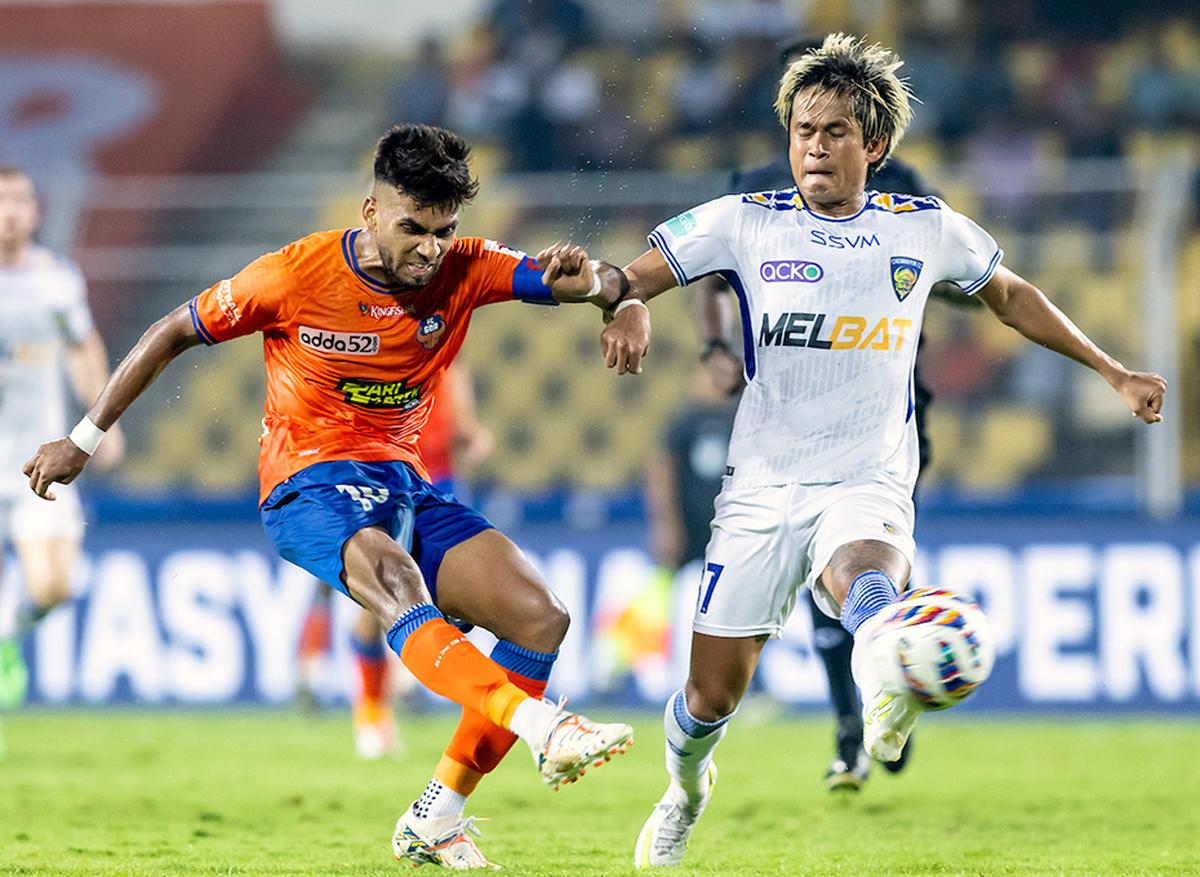
Powerhouse of promise: Brandon Fernandes (left) is perhaps the only one who possesses a technique comparable to that of Ahmed Jahouh, ISL’s best midfielder.
| Photo Credit:
PTI
Powerhouse of promise: Brandon Fernandes (left) is perhaps the only one who possesses a technique comparable to that of Ahmed Jahouh, ISL’s best midfielder.
| Photo Credit:
PTI
When Igor Stimac took over as the national team coach in 2019, he emphasised moving away from a long ball-oriented approach to a possession-based one, building attacks by passing from the back.
His preferred system is either 4-2-3-1 or 4-4-2, both of which require two central midfielders to play an integral role in breaking up play while funnelling possession from the backline and circulating it towards the attacking third of the pitch.
“We have improved our passing accuracy and possession; we have become more technical,” Stimac noted in 2021. Luckily for him, his tenure coincided with ISL teams adopting a possession-heavy style, with coaches from Spain, Germany, and the UK implementing this approach.
ALSO READ: Chhetri, Tendulkar and the roulette of fairytale farewells
But does India have enough midfielders who can implement this style? The ISL’s 3+1 foreigner rule and five-foreigner rule (2014 to 2020) prompted teams to look abroad for players who could raise the technical level of their side. This over-reliance on foreigners was not only for centre-forward and attacking midfield roles but also central midfield.
Historically, ISL teams have either deployed experienced foreigners in a two-man pivot in the midfield or paired a foreigner with an up-and-coming Indian in front of the back four.
The average age of an Indian midfielder in the league is 23.96, while for an overseas midfielder, it is close to 32. Therefore, the latter tends to dictate proceedings as the central figure while the domestic midfielder plays a supporting role.
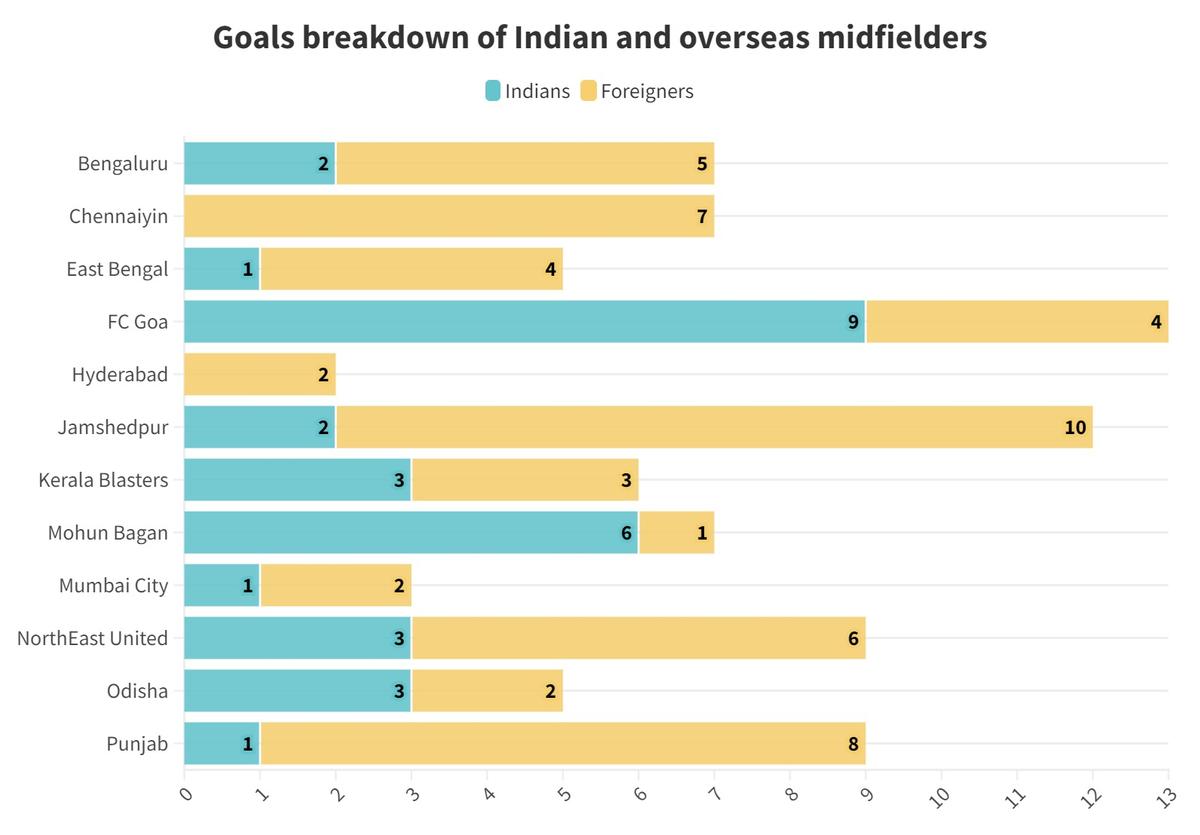
In recent years, successful teams in the ISL have followed this trend, such as: Mumbai City (‘23-’24) — Lalengmawia Ralte-Yoell van Nieff/Alberto Noguera, ATK Mohun Bagan (now called Mohun Bagan Super Giant) (‘22-’23) — Carl McHugh-Glan Martins/Puitea, Hyderabad FC (‘21-’22) — Joao Victor-Souvik Chakrabarti/Hitesh Sharma/Sahil Tavora and Mumbai City (‘20-’21) — Jahouh-Raynier Fernandes/Rowllin Borges.
Sahal Abdul Samad, who has long been admired for his dribbling and close control, never really found a regular run as a No. 10 player at Kerala Blasters
| Photo Credit:
RITU RAJ KONWAR
Sahal Abdul Samad, who has long been admired for his dribbling and close control, never really found a regular run as a No. 10 player at Kerala Blasters
| Photo Credit:
RITU RAJ KONWAR
However, success with an all-Indian double pivot is very rare. In the 2021-22 season, Scotsman Owen Coyle took Jamshedpur FC to the ISL Shield title with the pairing of Pronay Halder and Jitendra Singh. And with Chennaiyin FC in 2019-20, when it finished runner-up, Coyle preferred Anirudh Thapa to be partnered with either Edwin Sydney Vanspaul or Germanpreet Singh.
While the lack of centre-forwards in the national team besides Sunil Chhetri due to inadequate playing time in the ISL has been a long-standing issue, there are also concerns over attacking midfielders being played out of position. If Indian forwards are shifted to the wings to accommodate overseas exports, the central attacking midfielders will then have to fight it out with these Indian forwards for a place in the wings.
Due to the high-stakes environment of the top division league, coaches prefer overseas players over Indians in attacking midfield positions to maximise the threat upfront and minimise risks on the ball.
One of the Indian attacking midfielders, Sahal Abdul Samad, who has long been admired for his dribbling and close control, never really found a regular run as a No. 10 player during his time at Kerala Blasters. There was a perceived risk of him or any other inexperienced Indian losing the ball in the central areas of the pitch and exposing the team to counterattacks.
That trend would further add to Stimac’s frustration, who urged ISL clubs to play Indians in both centre-forward and attacking midfield positions. “This is the only way,” he said in an interview with Hindustan Times in 2023.
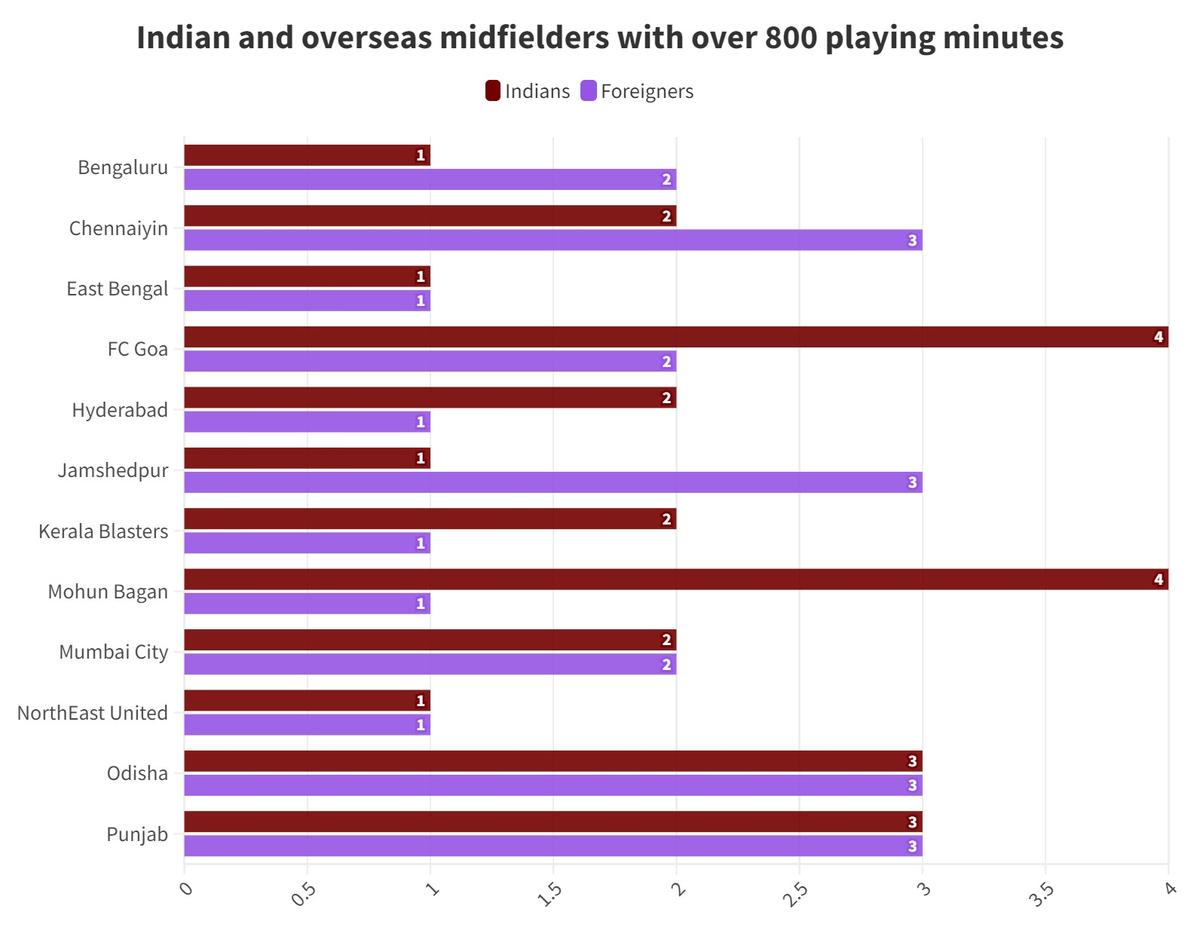
Even Brandon had to be shunted to the left flank in favour of overseas attacking midfielders. Thapa, who Coyle described as the ‘best Indian midfielder’,” was played out of position after his move to Mohun Bagan at the start of last season.
Injuries to defensive midfielders meant that Juan Ferrando, former head coach of the Mariners, played Thapa — a box-to-box midfielder — as a lone defensive midfielder, which didn’t work out too well.
The difference in playing time for Indian and overseas midfield players is quite lopsided. Among the 64 Indian midfielders who played in the 2023/24 ISL, only 26 completed 800 minutes or more. But among the 24 overseas midfielders, 22 played over 800 minutes.
The overseas midfielders bring valuable experience and technical prowess, significantly enhancing goal-scoring output in the final third (see graph). The foreigners have a hand in 105 goals (54 goals and 51 assists), dwarfing the Indians’ tally of 66 (31 goals and 35 assists).
At Chennaiyin, a 35-year-old Rafael Crivellaro, who had been out of action through injuries for the better part of 2021 and 2022, finished with four goals and seven assists this season while not even being at his best.
Every ISL team, except perhaps FC Goa, has a key overseas midfielder as the central hub, with an Indian player in a supporting role. The base of Goa’s midfield saw Carl McHugh being an ever-present fixture along with Rowllin Borges, Raynier Fernandes, and Ayush Chhetri as his midfield partners, while Brandon was the creative fulcrum in the No. 10 role. At FC Goa, the Indian midfielders outperformed the overseas midfielders in both goals and assists.
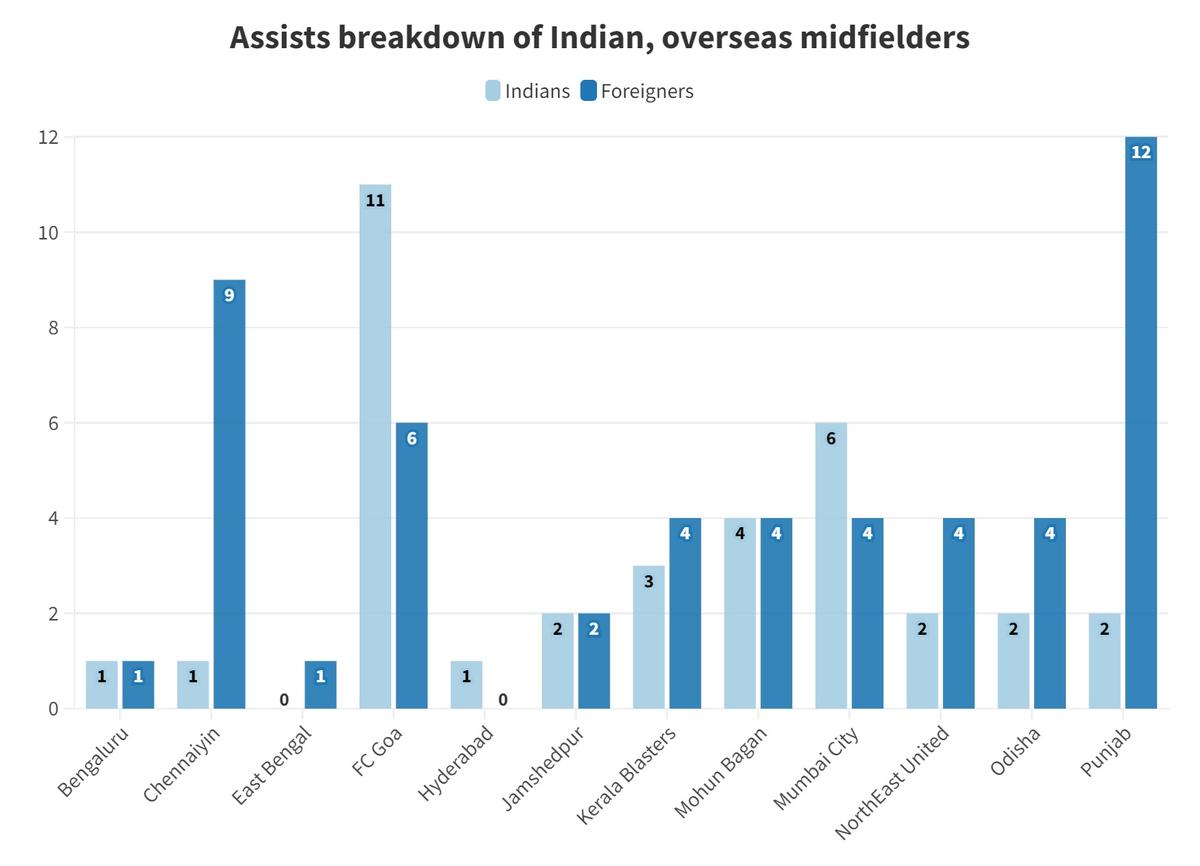
In the last seven ISL seasons, as the duration of the league expanded beyond three months, several midfielders have shown promise, but none have secured a central or attacking midfield position in the national team.
Midfielders like Anirudh Thapa, Sahal, Brandon, Lalengmawia, Rowllin, Deepak Tangri, Amarjit Singh Kiyam, Jeakson Singh, and Suresh Singh Wangjam have all been regular faces with the Blue Tigers but with mixed results.
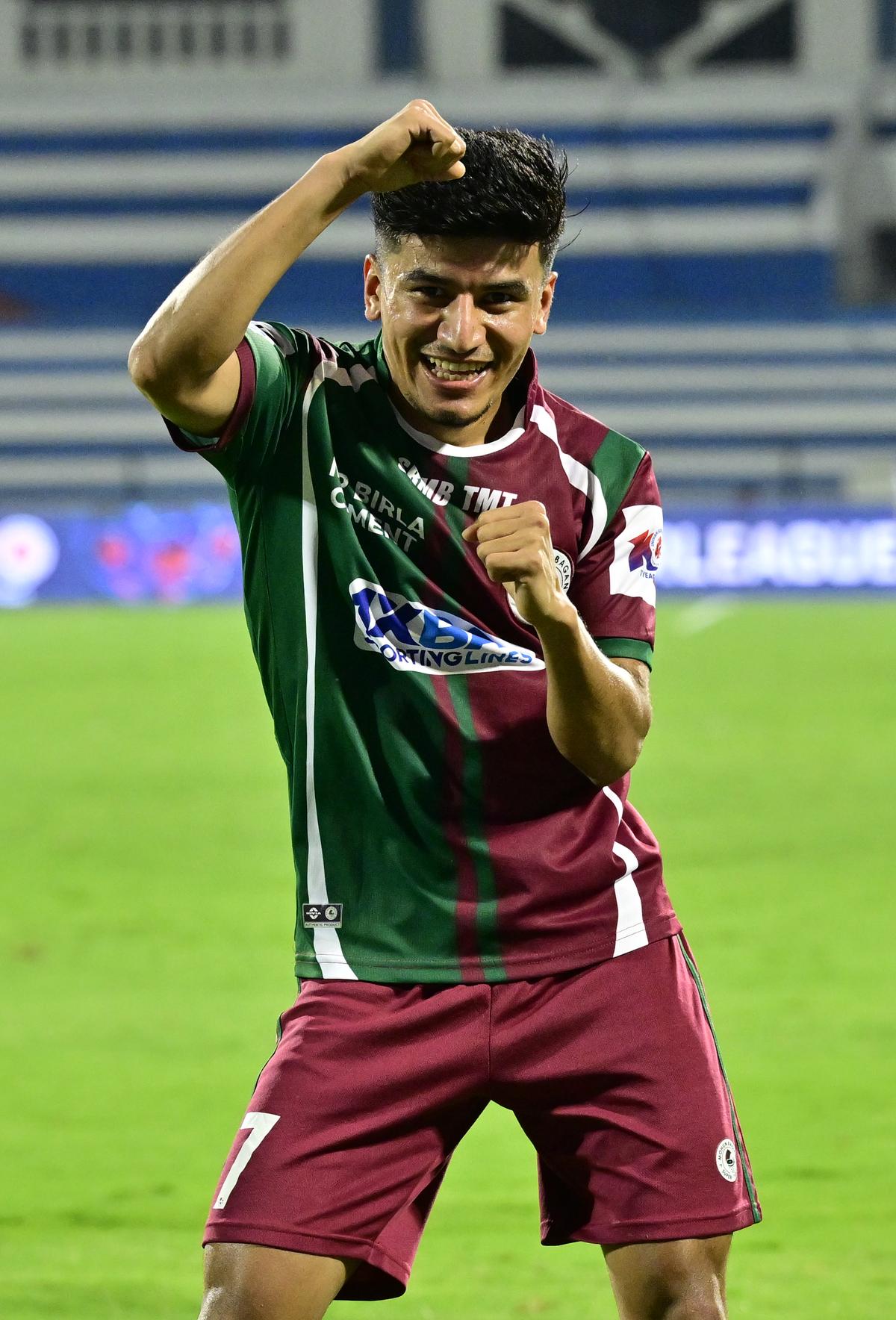
Anirudh Thapa.
| Photo Credit:
K. Murali Kumar
Anirudh Thapa.
| Photo Credit:
K. Murali Kumar
Thapa has been played as a No. 6, a No. 8, and a No. 10 without nailing down a specific position. Sahal, as an attacking midfielder in the No. 10 role, has been influential in the last year, but his output has been underwhelming with just two assists. Amarjit, who was Stimac’s preferred central midfielder in 2019, has had his progress derailed by injuries.
Brandon’s injuries had kept him out for over 18 months until his return to the national team earlier this year. Tangri, too, has had spells out with injuries, while Lalengmawia fell foul of Stimac last year but has since made a comeback. Suresh, on the other hand, has been woefully out of sorts in recent years.
Among them, Lalengmawia is the only player who possesses a well-rounded game both on and off the ball and can play both as a defensive midfielder and a box-to-box midfielder. At 23, his best years are yet to come. As for Brandon, his recent form in the ISL bodes well for the national team ahead of the World Cup qualifiers in June.
For the 41-man probables list, Stimac had rewarded Kerala Blasters’ Vibin Mohanan with a call-up after his excellent breakout campaign, but he was ultimately trimmed from the final squad. One player Stimac seemed to have overlooked recently is Lalthathanga Khawlhring, also known as Puitea. Playing alongside someone of the quality of Jahouh has helped revitalise the diminutive central midfielder, who moved from Mohun Bagan to Odisha this summer. He was the best passing Indian midfielder this season with 919 completed passes, 683 more than his previous season’s count with the Mariners, having played nine additional matches.
Passing isn’t the only metric that determines the quality of a midfielder. To become a complete midfielder, one should also excel in positioning, tackling, aerial duels, and interceptions. Puitea, with a dribbling ability that’s unique among Indian deep-lying midfielders, has had his best campaign this year. However, he is yet to earn a senior India cap. His only call-up in the last 12 months was in March ahead of the Afghanistan World Cup qualifier. He was included in the probables list, but the 26-year-old was cut from the eventual squad.
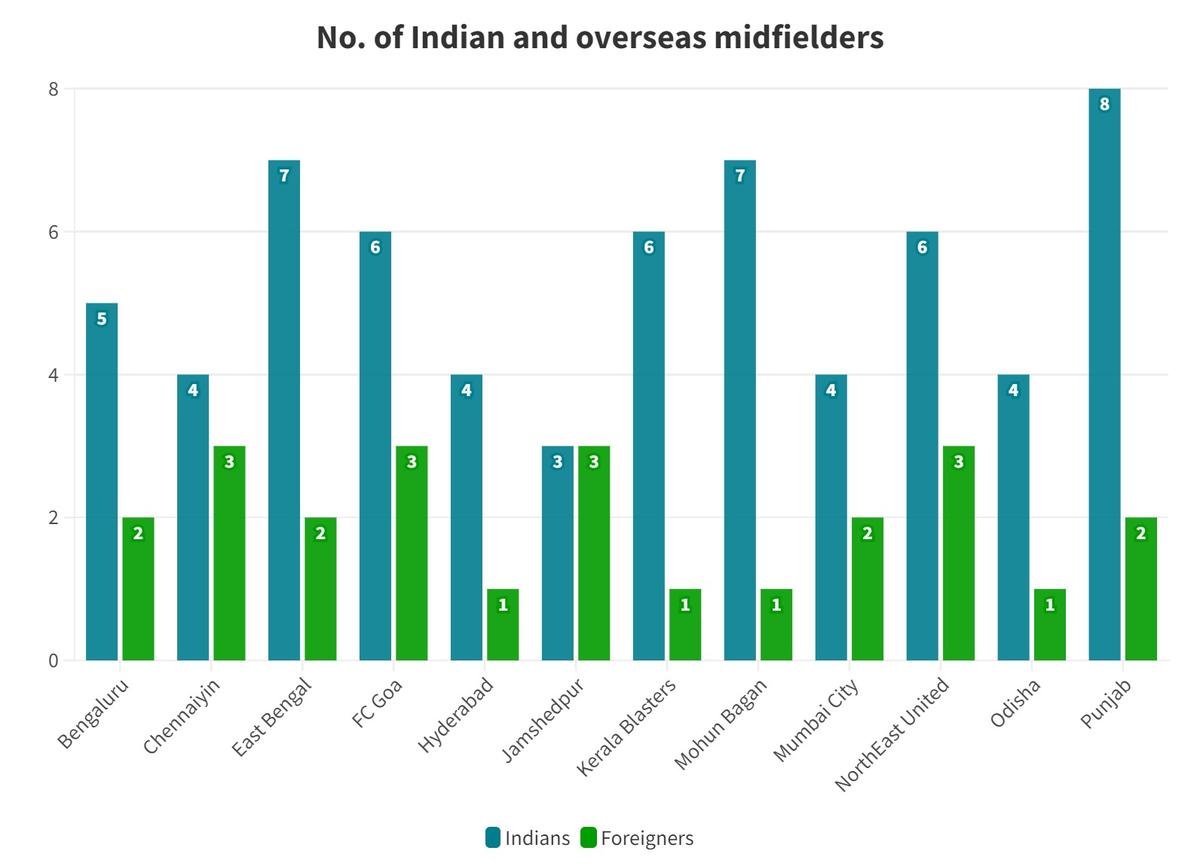
Often, when pitted against higher-ranked opponents, India has come unstuck due to its inability to progress the ball from the back to the front or control phases of play. Central midfielders with a wide passing range, who can play themselves out of tight spaces, could solve some of these problems.
If India hopes to secure any points in the upcoming qualifiers and aims to achieve World Cup third-round qualification, it could utilise Puitea alongside Lalengmawia in the double pivot role. But Stimac’s preference for aerial strength in the form of Jeakson seems to go against the Odisha midfielder.
Apart from them, youngsters like Jiteshwor Singh and Ayush Adhikari (Chennaiyin), Nikhil Prabhu (Punjab FC), Mark Zothanpuia and Lalchhanhima Sailo (Hyderabad), Harsh Patre (Bengaluru), Abhishek Suryavanshi (Mohun Bagan) — all of whom are aged under 24 and have played over 800 minutes — have impressed, but most of them play for clubs that finished in the bottom half of the table.
The youthful profile of an Indian midfielder and the limited playing time in midfield positions in the top division doesn’t augur well for Stimac and the national team.
Mumbai City’s title-winning coach Petr Kratky said after winning the ISL trophy, “I was talking to our sports director and said I would want to win the ISL trophy with only Indian players. But there is no denying that foreign players bring quality and experience that Indians can learn from.”
While foreigners like Jahouh and Noguera rightly bring in the know-how to help Indian midfielders, the reason for the league’s existence will become moot if Indians don’t get the space to develop their game and reach greater heights.


